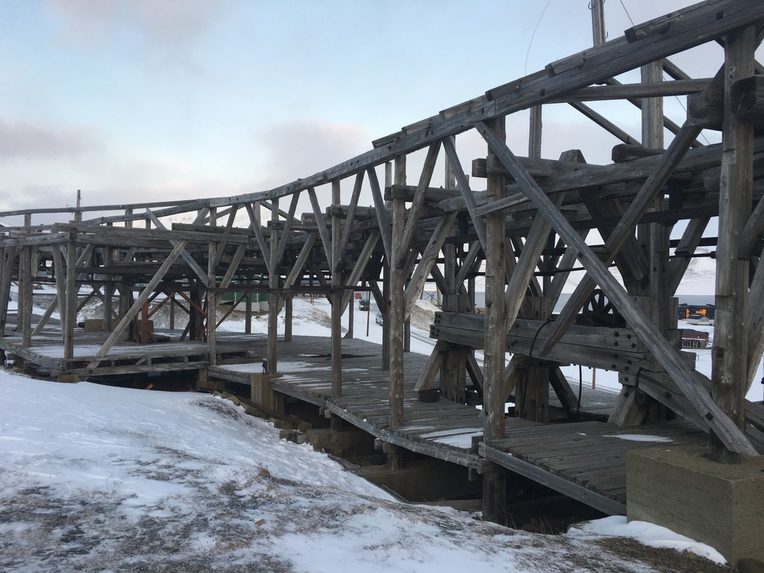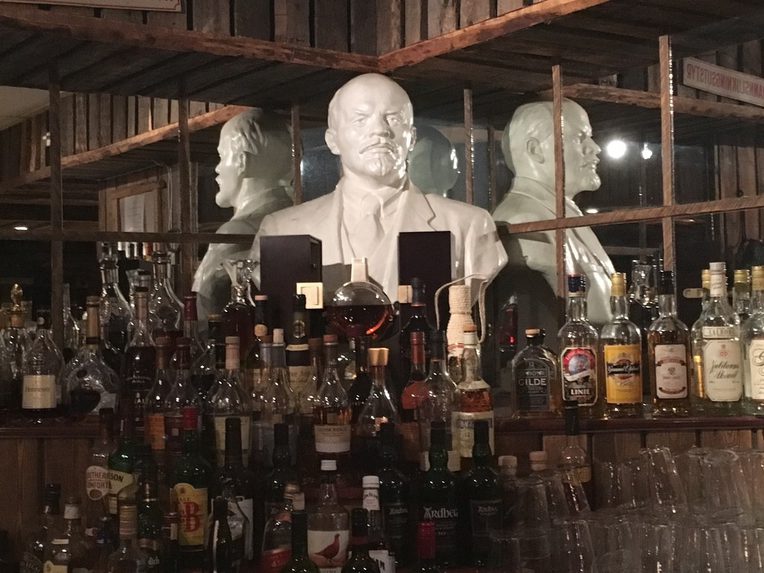Ruin
From the Series: Lexicon for an Anthropocene Yet Unseen
From the Series: Lexicon for an Anthropocene Yet Unseen

To contemplate the end of the world, I had to get there. So I flew to Longyearbyen, the largest permanent settlement in a Norwegian archipelago called Svalbard, inside the Arctic Circle. Less than a thousand kilometers from the North Pole, over sixty percent of Svalbard’s land mass is covered by glaciers. Longyearbyen is named for John Munro Longyear, an American capitalist whose name suggests a temporal slackening. Longyear arrived in Svalbard and saw riches in the plentiful coal seams that marked the land, Triassic gashes just beneath or on the earth’s surface where glaciers had carved away the mantle. Coal is, of course, dead organic matter: all that shiny black sediment is the detritus of deciduous forests and puzzlegrass that flourished in a balmier Svalbard sixty-five to twenty-three million years ago, their dead tissue inspissated by heat and pressure until latent energy condensed into something combustible.

Longyear’s Arctic Coal Company began operating in 1906; its first mine was dug into the slopes of Platåberget mountain, which casts its shadow on the town below. Though coal mining in Longyearbyen is largely shuttered now, its infrastructure remains scattered across Longyearbyen’s landscape. The dark skeletal remains of coal tipples, lift systems, and aerial tramway conveyors litter the surrounding mountains, looking much the way they were left. They resist decay because the temperature is too cold for liquid water to rot wood. Like the coal seams for and upon which they were built, these abandoned mines are ruins that will remain indefinitely.

Across the fjord from Longyearbyen is Pyramiden, a Soviet mining town that was abandoned to the elements in 1998. The closest I could get to Pyramiden in February was visiting the Longyearbyen library. There, I learned that Pyramiden was designed to conquer the formidable climate of the high Arctic: miners could swim in a salt-water swimming pool, eat from a greenhouse that grew cucumbers and herbs, and walk across specially cultivated grass designed to be hardy enough to flourish in the frigid town square. The town also boasted a basketball court, a library, a nightclub, and a museum among other urban conveniences.

Ten years after its closure, two archaeologists and a photographer documented the ghost town after a decade of neglect. In their words, “ruins such as Pyramiden . . . have their own historical mission: they rescue a forgotten past, not as heritage, at least not in any ordinary sense, but as a kind of involuntary memory that illuminates what conventional cultural history has left behind. They bring forth the abject memories that this history has displaced” (Andreassen, Bjerck, and Olsen 2010, 152). When the Longyearbyen library closed later that night, I crossed the street to sit at one of the two bars in town, drinking beneath Lenin’s steely gaze. I asked the bartender what she knew about this bust and she shrugged: “Someone found it over in Pyramiden a few years ago.”

What is a ruin? Let’s page back to Walter Benjamin (2003, 166), who described history “as a petrified, primordial landscape”—nature frozen or turned to stone. For Benjamin, as he surveyed the ruins of Europe, an architectural ruin was an allegory for history, a history that is millennial but not dialectical. Phrased somewhat differently, history is a perpetual catastrophe occupying the caesura between past and present. Benjamin triangulated between history, life, and ruin, as all three are temporal allegories for one another: ruins fall apart, life decays, and history tends toward tragedy. Could Arctic ruins, then, be allegories for the Anthropocene? They are places where the corrosive force of history gnaws into a petrified present, threatening to degrade an uncertain future.
Longyearbyen is now a former coal-mining town whose miners are out of work. An influx of scientists has begun taking their place, propping up a zombie economy with research grants from nations around the world. The coal mines in the nearby settlement of Ny-Ålesund closed after an explosion killed twenty-one miners in 1963, and today the town enjoys a second life as a research station. Each former coal miners' cabin now belongs to a different nationality of scientists.
These scientists arrive in Svalbard, in perfect irony, to observe anthropogenic climate change. As all of Svalbard’s coal was extracted and combusted over the course of the twentieth century, atmospheric carbon dioxide levels rose. Svalbard is particularly sensitive to climate change; temperatures in the area increase more than one degree Celsius every decade, well above the global average. That means that one of the coldest places on Earth is warming up faster than the rest of the planet, and the glaciers whose tongues and feet and snouts had waxed and waned along depressed arêtes for hundreds of thousands of years are now receding. As their mass balances shift, they calve and let loose and the temperatures rise, and the waters rise, unleashing a terrible positive feedback cycle.
Today, one can look out onto Longyearbyen’s landscape and see smoke from one of Svalbard’s few remaining coal mines smoldering from the chimney of Norway’s last coal-fired power plant, clouding the view of the Larsbreen glacier on the horizon. As temperatures rise, once-ossified Arctic ruins, like glaciers and other solid things, threaten to melt into corrupted air.
Andreassen, Elin, Hein Bjartmann Bjerck, and Bjørnar Olsen. 2010. Persistent Memories: Pyramiden—A Soviet Mining Town in the High Arctic. Trondheim, Norway: Tapir Academic Press.
Benjamin, Walter. 2003. The Origin of German Tragic Drama. Translated by John Osborne. New York: Verso. Originally published in 1963.